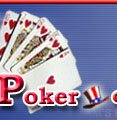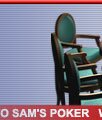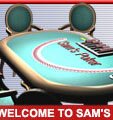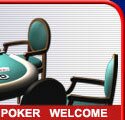|
Poker Strategy
The four basic skills
Poker pros are commonly described as tight and aggressive: "These poker pros do not play many hands, but when they play them, they play them like they had the nuts."
That's a nice general description, but it doesn't say much. And it's not even totally right about no limit games, as a solid loose, aggressive player is a person to be feared. Thus, when I think people say a player is tight/aggressive and therefore good, I really think they mean that the player has mastered four critical elements of poker.
#1. Math skills
Good poker players know general percentages. They know that you have about 1 in 8 chance of hitting a set when holding a pocket pair, and that you have about a 1 in 3 chance of completing a flush draw at the flop.
They know the importance of 'outs.' Outs are simply the number of cards that will improve your hand. Count your outs, multiply them by two, and add two, and that's roughly the percentage shot you have at hitting.
They can figure out the 'pot odds'. Knowing outs is meaningless unless it's translated into rational, calculated betting. Knowing you have a 20% chance of hitting, what do you do then? Well, simply once you figure out your chance of hitting/winning, you divide the size of the pot at the river (i.e. the current pot plus the amount of money that you think will be added through future bets) by the amount you have to put in. If you have a 20% chance of hitting and the bet to you is 50, if the pot at the river will be greater than 250, call. If not, fold.
Math skills are the most basic knowledge. The purpose of this book is not to go over pot odds, implied odds, etc. That's day one reading. Anyone who doesn't understand these concepts should not play in a game until they do.
#2. Discipline
Good poker players demand an advantage. What separates a winning poker player from a fish is that a fish does not expect to win, while a poker player does. A fish is happy playing craps, roulette, the slots; he just hopes to get lucky. A poker player does not hope to get lucky; he just hopes others don't get lucky.
Good poker players understand that a different game requires a different discipline. A disciplined no limit player can be a foolish limit player and vice versa. A disciplined limit player is always very tight preflop. He or she will not play too many hands, only the ones that have a very good chance at winning.
However, a disciplined no limit player is VERY different. This player is not so concerned with paying too many blinds; instead, he or she does not want to get trapped. The main difference between a disciplined limit and no limit player is that the limit player avoids piddling away his stack bit by bit while a disciplined no limit player avoids losing his whole stack in one hand. Hence, a disciplined no limit player can play a lot of hands. Preflop, he or she can be as loose as 'that' girl in high school. However, a good no limit player knows when to toss hands that will get him or her in trouble.
A disciplined player knows when to play and when to quit. He recognizes when he is on tilt and is aware when a game is too juicy to just quit while ahead.
A disciplined player knows that he is not perfect. When a disciplined player makes a mistake, he learns. He does not blame others. He does not cry. He learns from the mistake and moves on.
#3. Psychological Skills
A good player is not a self-centered player. He may be the biggest SOB you know. He may not talk about care about anyone but himself and may enjoy stealing food from the poor. However, when a poker pro walks into a poker room, he always empathizes with his opponents. He tries to think what they think and understand the decisions they make and why they make them. The poker pro always tries to have an answer to these questions:
a- what does my foe have
b- what does my foe think I have
c- what does my foe think I think he has
Knowing the answer to these questions is the first step, manipulating the answers is the second and more important step. If you have a pair of kings and your foe has a pair of aces, and you both know what each other have and both know that you each know what the other has, why play a game of poker? A poker pro manipulates the latter two answers by slowplaying, fastplaying, and bluffing in order to throw his opponent off.
Good poker players know that psychology is much, much, much more important in a no limit game than in a limit one. Limit games often turn into math battles, while no limit games carry a strong psychology component. I would NEVER play against a solid computer 'bot' in a limit game. However, in a no limit game, that bot would be toast.
#4. A Clear Understanding of Risk-vs-Reward
Pot odds and demanding an advantage fall into this category. Poker players are willing to take a long shot risk if the reward is high enough, but only if the expected return is higher than the risk.
More importantly, they understand the risk-vs-reward nature of the game outside of the actual poker room. They know how much bank they need to play, and how much money they need in reserve to cover other expenses in life.
Good poker players are fundamentally slightly risk-averse. In economics, a person is defined as risk-neutral, risk-averse, or risk-loving, depending on how that person rewards the next dollar they gain or lose. Risk loving are perfectly happy risking their entire roll on an even odds bet, a risk-neutral person is indifferent towards it, and a very risk-averse person would never risk his whole roll. Thus, a good poker player is slightly risk averse b/c he demands a big enough advantage to not be considered 'risk-neutral,' but he tends to value every dollar in his roll equally. If you cannot afford to lose your entire roll, you should not be playing with that much money.
Starting Hands
The first thing you must understand when you play Texas Holdem is which hands are good and which are bad. Though it depends on the number of people in the game and the type, here is a general guide to use when you are just starting out but want to be a winning player at the lower limits. I suggest starting out at a fixed limit of $1-2 or lower.
Hands to Raise with:
These are 'premium hands' that you want to jam the pot with preflop:
AA, KK, QQ, AK, JJ, AQ, 1010
Hands to call with:
You want to see the flop with these hands and then decide. Do not call three bets with these hands, call only one or two.
AJ, KQ, QJ, J10, 109 (only if of same suit),99, 88, 77, Ax (same suit)
Pot Odds
Once you hit the flop, you should use pot odds to decide your next action. When you hit the flop, either you will be winning or hopefully winning (with a made hand) or you want cards to improve your hand (you are drawing). If you have a made hand, you should bet and raise. You want to win the pot now because more cards can only help your opposition. An example of a made hand is if you hold AK and the board is KJ4.
If you do not have a made hand, you are drawing. You must use 'pot odds' to determine if you should call or fold. First, you must count the number of outs you have. An out is a card that will make your hand the best hand. For example, if your hand is KJ, and the board is Q 10 7, then your outs are 4 Aces and 4 9's, or 8 outs total. To calculate your percentage of hitting an out, you take the # of outs X 2 + 2. Once you figure out this number, you multiply it by the pot to see what the maximum bet is that you can call. For example, if you have 6 outs (6 cards will help you), you have about a 14% chance of hitting. If the pot is 100 and you must call 10, you should call b/c you can call up to $14 (.14 X 100) but the cost is only $10. However, if the bet to you was $20, you should fold Because that would require a 20% chance of hitting.
Deception
Bluffing and Slowplaying are two deceptive techniques you should employ.
Bluffing
Contrary to popular belief, bluffing is almost useless in a low limit game (anything less than $2-4). Rarely will people not call to a showdown, so there is no point in scaring people out of the pot. I suggest waiting to bluff until you play at a higher limit. When you play at a higher limit, it's best to bluff when you 'represent' something and there are only one or two opponents in the pot. For example, betting at the flop with a high card on the board 'represents' a pair, raising when a flush is possible 'represents' the flush.
Slowplaying
Slowplaying means deceiving your opponents into thinking you have less of a hand then you do. For example, suppose you hold KK. The flop comes K33, so you flopped a full house! There is no need to scare people out of the pot because there is little chance of someone drawing out on you. Thus, you should wait to the turn or maybe even river to jam the pot with bets and raises. You should slowplay if two conditions are met:
1. You hold a whopper and there is almost no chance of someone drawing on you
2. You will only get action if some other cards come out that will improve your opponents' hands, but these cards are not good enough to make these hands beat yours.
Click here to download our multiplayer online poker games and tournaments. Play Texas Hold'em and other internet poker games online at Sams Poker. Blackjack Tournaments Online found exclusively at Sams Poker. Also, enjoy a friendly game of Gin Rummy at our internet poker room. Gin Rummy tournaments online are coming soon! Press here to join our poker party today! To begin our free poker software download now you can also press the "play now" button bellow! Don't forget to register for the Sams Poker newsletter. Weekly newsletters are sent out to subscribers with the best online poker bonuses on the net. See you at the poker tables!
|












